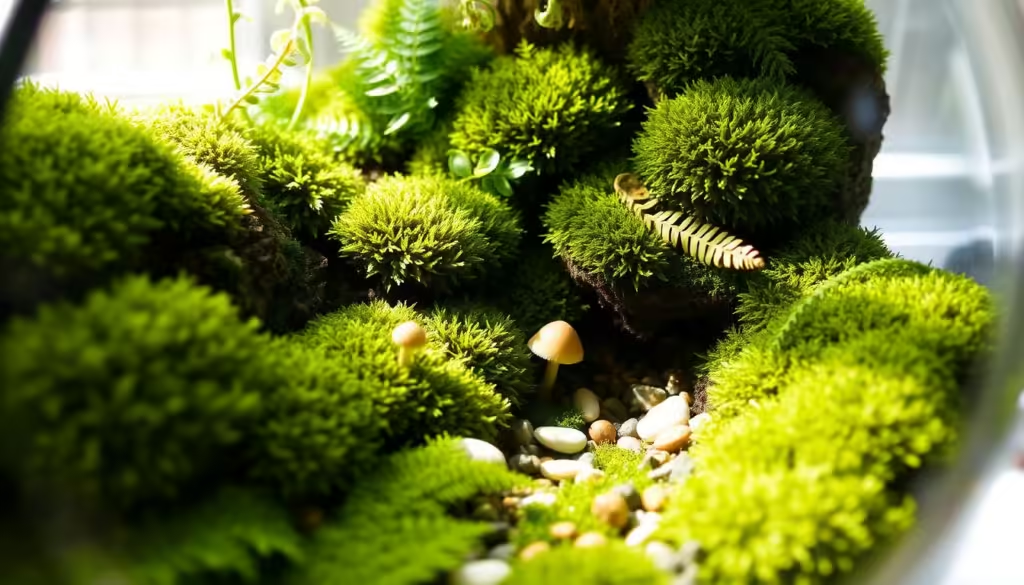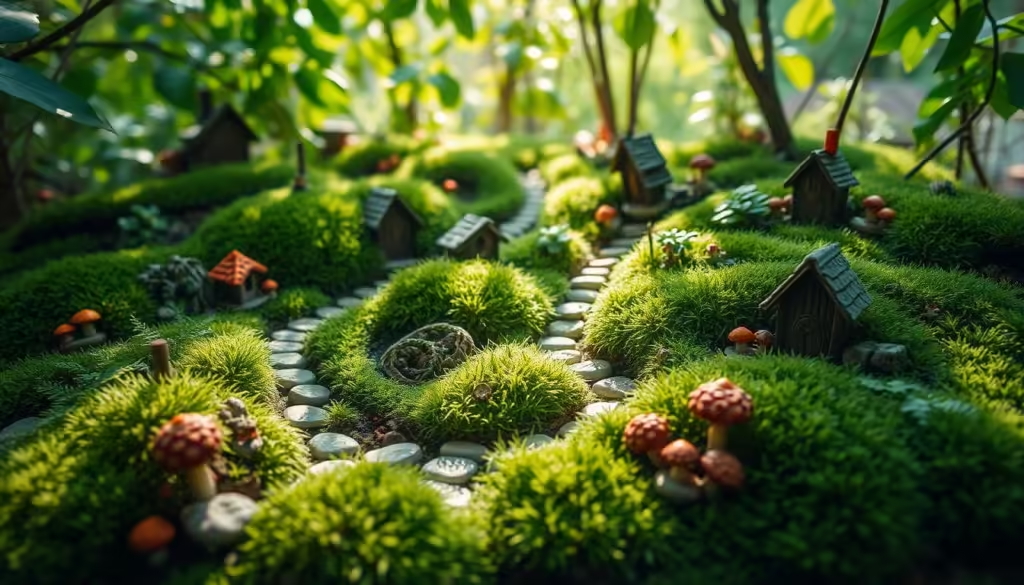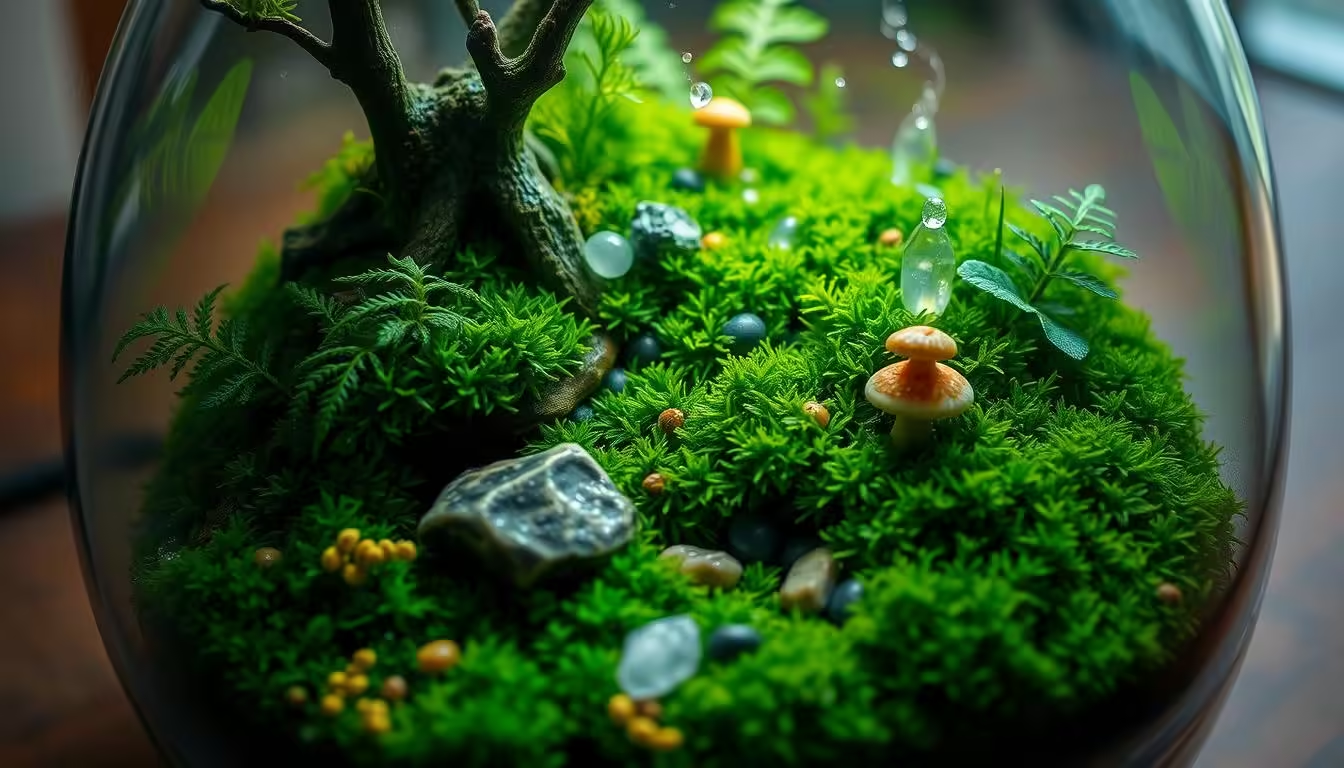Step into a world where nature meets magic. Moss terrarium plants create a self-sustaining ecosystem in your home. They bring verdant beauty and peace into your life.
Looking at the moss in your terrarium feels like time stops. These plants calm your mind and soothe your soul. They turn your home into a peaceful oasis.
Key Takeaways
- Moss terrariums allow you to create a magical, self-sustaining ecosystem in your home.
- Moss plants thrive in the humid, low-light conditions found within a terrarium.
- Crafting a moss terrarium is a versatile and low-maintenance hobby that appeals to both adults and children.
- Moss terrariums can be customized to reflect your personal style and preferences.
- Caring for a moss terrarium involves maintaining humidity and providing the right lighting conditions.
What are Moss Terrarium Plants?
Moss is a special group of small plants that don’t have true roots, stems, or leaves. They absorb water and nutrients through their delicate leaves. Moss has been on Earth for about 450 million years.
In terrariums, moss creates a humid, shaded space that feels like a forest. Its different growth patterns and textures add beauty and interest to a moss terrarium.
Understanding Moss and Its Role in Terrariums
Moss is great for terrariums because it looks beautiful. Its green colors and detailed leaves make terrariums magical. Moss is also easy to shape and arrange to fit any design.
Moss helps keep the right amount of moisture in terrariums. It also provides a home for tiny animals like springtails and isopods. These creatures help keep the terrarium healthy.
Benefits of Using Moss in Terrariums
- Moss adds visual interest and texture to terrariums.
- Moss helps regulate humidity levels in closed terrarium environments.
- Moss creates a habitat for beneficial microfauna, supporting a balanced ecosystem.
- Moss is highly versatile and can be easily arranged to suit the desired aesthetic.
- Moss is an ancient and unique plant, offering a touch of enchantment to terrarium designs.
“Terrariums are a current big trend in gardening, and moss is an essential component for creating these miniature, self-sustaining ecosystems.”
Best Moss Varieties for Terrariums
Choosing the right moss for your terrarium can make it truly special. Two top picks are cushion moss and mood moss. They add beauty and life to your mini garden.
Cushion Moss (Leucobryum glaucum)
Cushion moss, or Leucobryum glaucum, is a favorite among terrarium lovers. It looks like soft, green hills. This makes it perfect for filling gaps and adding depth to your terrarium.
It’s also very flexible. You can shape it to fit your terrarium’s design. Plus, it loves the humid, dark spots found in terrariums.
Mood Moss (Dicranum spp.)
Mood moss, or Dicranum spp., is another great choice. It has a delicate, wispy look. Its leaves seem to move in the breeze.
Mood moss comes in many colors, from bright greens to autumn shades. It’s great for adding contrast and interest to your terrarium. Like cushion moss, it thrives in terrarium conditions and makes a lush ground cover.
Both cushion moss and mood moss are top picks for terrariums. They bring unique textures and colors. Adding them can make your terrarium a magical, miniature world.
Terrarium Gardening with Moss
Choosing the right container is key for a moss terrarium. Glass containers like jars or vases work best. They keep the humidity high, which moss loves. The size of your terrarium container should match your moss project.
Choosing the Right Terrarium Container
The substrate is vital for a moss terrarium. You need a mix that drains well but holds moisture. A blend of coconut coir, perlite, and charcoal is great. It keeps the soil for moss terrariums moist and supports the moss.
“Moss terrariums are designed to be low maintenance, requiring little to no upkeep, while maintaining humidity and providing adequate light.”
How to Plant moss terrarium plants
Creating a moss terrarium is a fun and rewarding project. It brings the beauty of moss into your home. Planting moss in a terrarium is a simple yet detailed process. By following these steps, you can make a lush, natural display that will amaze and inspire you.
Step-by-Step Guide to Planting Moss
Start by cleaning and checking the terrarium container for any dirt or debris. Then, make a sloping layer of soil mix. This mix should include potting soil, sphagnum moss, and builder’s sand. Place rocks or driftwood in the soil to add depth and interest.
Now, it’s time for the moss. Tear or cut the moss into smaller pieces for easier placement. Arrange the moss on the soil, pressing it gently to help it stick. Finally, mist the moss with water to keep it moist.
Tips for Arranging Moss in Terrariums
When arranging moss, think about its natural growth and texture. Cushion moss is great for filling spaces and creating hills. Mood moss adds soft, wispy touches. Try placing moss over rocks or on driftwood to create a natural look.
With the right care, the moss will grow and fill your terrarium. It will become a lush, enchanting world to enjoy for years.

Caring for Your Moss Terrarium
Keeping the right watering and humidity levels is key for your moss terrarium’s health. Moss loves moisture and grows best in humid places. Use a spray bottle to mist the moss and soil often. This keeps the soil damp but not too wet.
If your terrarium has an open top, cover it with a lid or plastic wrap. This helps keep the humidity in. Watch the moisture levels closely. Too much or too little water can harm the moss.
Watering and Humidity Requirements
Moss terrariums need a balance of water and humidity to grow well. Here are some tips to keep your moss healthy:
- Mist the terrarium with a spray bottle 2-3 times a week. This keeps the soil damp but not too wet.
- Consider covering the terrarium with a lid or plastic wrap to keep humidity high.
- Don’t let the moss dry out completely. This can kill it.
- Keep an eye on the moisture levels and adjust your watering as needed.
Lighting Needs for Moss Terrariums
Moss does well in low-light conditions. It prefers indirect, diffused light, like a north-facing window or a shaded area. Avoid direct sunlight, as it can dry out the moss and stress it.
If you don’t have natural light, use a terrarium light or a low-wattage LED bulb. The goal is to give the moss enough light to stay green without too much direct sunlight.
By following these tips for watering, humidity, and lighting, you can create a beautiful moss terrarium. It will add natural beauty to your space.
Moss Terrarium Plants and Miniature Gardens
Moss terrariums are perfect for fairy gardens, making them magical and enchanting. The soft, green moss is great for creating a fairy garden’s base. You can shape it like hills or forest floors.
Add tiny fairy figures, houses, and items to make it come alive. This mix of moss and fairy stuff brings out the wonder and creativity. It turns a simple terrarium into a magical small-scale garden.
Incorporating Moss into Fairy Gardens
Moss is not just for fairy gardens. It’s also great for making other miniature scenes in terrariums. You can shape it to look like woodlands, waterfalls, or mountains.
By using different moss varieties and small accessories, you can create detailed, self-contained worlds. These worlds feel like they’re from a miniature world. Plus, moss terrariums are easy to care for, perfect for showing off your creativity.

“The combination of moss and fairy-inspired elements cultivates a sense of wonder and imagination, transforming a simple terrarium into a captivating small-scale garden.”
Low-Light Plants to Complement Moss Terrariums
Creating a stunning moss terrarium is more than just the moss. Adding low-light plants that love the same humid, shaded spot enhances it. These plants add depth, texture, and interest to your indoor garden.
Ferns like the Lemon Button Fern or Boston Fern are great for moss terrariums. They thrive in the moist, humid air moss creates. Peperomia species, with their bright leaves and small size, also add color and unique shapes.
The Ficus pumila, or creeping fig, is perfect for a cascading look. Its heart-shaped leaves spill over, adding depth and elegance. The Macodes petola, or lightning jewel orchid, has striking leaves that grab your attention.
Choosing plants that match the moss’s care needs creates a balanced, beautiful terrarium. Whether you pick ferns, Peperomias, or vines, your moss terrarium will be magical.
| Plant | Characteristics | Suitability for Moss Terrariums |
|---|---|---|
| Lemon Button Fern | Delicate, low-light loving, compact growth | Thrives in the moist, humid conditions created by moss |
| Peperomia caperata | Vibrant foliage, compact growth habit | Adds pops of color and texture to the terrarium |
| Ficus pumila (Creeping Fig) | Trailing, cascading growth, heart-shaped leaves | Creates a sense of depth and natural elegance |
| Macodes petola (Lightning Jewel Orchid) | Striking leaf venation, low-light tolerant | Captivating addition to the terrarium |
Adding these plants to your moss terrarium makes a beautiful, easy-to-care-for mini oasis. Moss and foliage together create a serene, enchanting space in your home.
Troubleshooting Common Issues with Moss Terrariums
Moss terrariums are easy to care for, but sometimes they face common problems. Issues like discoloration, wilting, or mold can signal a problem with moisture or light. It’s important to watch the moss closely and fix any issues quickly. This might mean changing how often you water or adding more air.
Identifying and Addressing Moss Problems
Too much moisture in closed terrariums can cause mold. To fix this, you can add springtails, which help clean up mold naturally. Both open and closed terrariums need little water. Closed ones might not need water at all because they trap moisture.
Bad lighting can make moss look leggy or turn brown. Keep an eye on your terrarium for any signs of trouble. This way, you can act fast and keep your moss healthy.
Reviving Struggling Moss Terrariums
If your moss terrarium is struggling, like it’s browning or drying out, there are steps to help. Start by removing dead or damaged moss. Then, check the soil and light. Make sure the soil is damp but not too wet. Also, give it bright, indirect light to encourage new growth.
In some cases, you might need to remove all the moss, clean it, and put it back with fresh soil. With care and patience, even a struggling moss terrarium can come back to life.
Moss Terrarium DIY Projects and Ideas
Moss terrariums are not just about the plants. They’re also about the creative containers they live in. Think outside the box with items like old glassware, vintage jars, or even logs and shells. These unique containers can make your diy moss terrarium stand out as a piece of art.
The design of your moss terrarium is where you can really get creative. Add driftwood, rocks, or tiny figurines for depth. Mix different mosses for texture and color. You can even add fairy accessories or create a moss “tree” for fun. Moss terrariums let your imagination run wild, creating a mini world in a container.
Creative Moss Terrarium Containers
Choosing the right container is key for your moss terrarium. It should be the right size and shape for the moss to grow well. Here are some creative containers for moss terrariums to spark your next project:
- Repurposed glassware, such as apothecary jars, mason jars, or vintage decanters
- Unique found objects, like hollowed-out logs, seashells, or even old teacups or teapots
- Geometric terrariums, such as glass cubes or pyramids, for a modern, minimalist look
- Hanging glass orbs or globes to create a suspended, floating effect
- Vintage or antique containers, like old lanterns or bird cages, for a touch of whimsy
Unique Moss Terrarium Designs
There are countless unique moss terrarium ideas and designs to explore. Let your creativity shine and try out different moss terrarium inspiration for a one-of-a-kind piece. Think about adding:
- Layered landscapes with varying textures and elevations
- Miniature figurines, crystals, or other decorative elements to tell a story
- Cascading moss, creating a lush, natural waterfall effect
- Moss-covered branches or driftwood to add depth and visual interest
- Succulent or air plant companions to complement the moss
The charm of creative moss terrarium ideas is they can transport you to a magical world. All from the comfort of your home.
Conclusion
Moss terrariums are a beautiful way to add nature’s calm to your home. They create a tiny world that fills you with wonder. You can make a fairy garden, a woodland scene, or just enjoy the greenery.
There are many moss types to choose from, so you can make your terrarium unique. They work well with other plants that like low light. This lets your creativity shine as you make your moss terrarium.
Moss terrariums are a special way to add nature to your home. They have calming green colors and are easy to care for. They make a beautiful spot in any room.
As you learn about moss terrariums, let your imagination run wild. Make a space that shows off your style and personality. Watch as your moss terrarium grows and becomes a magical part of your home.
FAQ
What are the benefits of using moss in terrariums?
What are some popular moss varieties for terrariums?
What kind of container is best for a moss terrarium?
What kind of substrate is best for growing moss in a terrarium?
How do I care for a moss terrarium?
Can I incorporate other plants into a moss terrarium?
How do I revive a struggling moss terrarium?
What kind of creative containers can I use for a moss terrarium?
Want To Learn More, Check Out These Links:
- Terrarium Moss: The Secret to a Vibrant Terrarium
- Terrarium plants – Blooming Lucky
- 25 best terrarium plants for beginners
- Mood Moss 101: Growth & Care Guide (Dicranum scoparium)
- Moss for Terrariums | The Gilded Garden
- Magical Fairy Garden Terrarium Guide (For Kids & Adults)
- How to Make a Moss Terrarium (DIY Mossarium): Step-by-Step
- How to Make a Moss Terrarium Using Items You Already Have on Hand
- You Can DIY Your Own Terrarium in 7 Simple Steps—Here’s How
- Terrarium Plants For Sale| Fast Shipping
- Moss Terrariums: Moss and Bugs, in your home, cheap!
- Preserved Moss Terrarium: The Vertex II – R by TerraLiving | TerraLiving Gallery
- These 12 Terrarium Plants Will Look Adorable in Your Mini Garden
- 10 Low Light Terrarium Plants (That’ll Thrive in the Shade!)
- 25 Easy Terrarium Plants for Open or Closed Glass
- Terrarium Troubleshooting: How to Fix Common Problems – Unlock The Secrets of Building Beautiful Terrariums Today
- DIY terrarium – an easy upcycling project that anyone can do!
- A Kid-Friendly Terrarium DIY — Carmen Johnston Gardens
- Turn A Jar Into A DIY Terrarium
- The Art & Care of Terrariums | Gardens of Babylon

